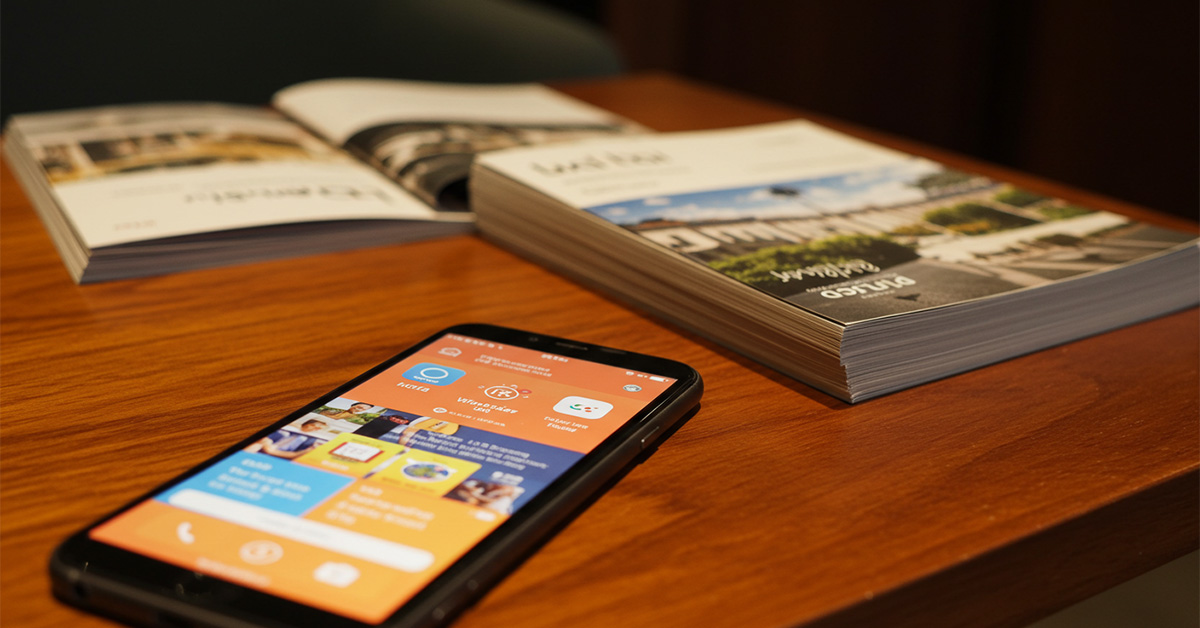In the digital age, declaring print marketing obsolete has become something of a mantra. However, for those in the hospitality sector, dismissing print entirely is a premature conclusion. While the digital revolution has undeniably transformed marketing, particularly in industries like tourism and hospitality, traditional print mediums retain a potent and often overlooked value.
Digital marketing’s ascendance is undeniable. Online Travel Agents (OTAs) dominate booking platforms, and social media dictates trends and captures attention. It’s a digital-first world, and for good reason. Yet, in this rush to embrace the new, we risk overlooking the enduring power of established marketing channels.
This article isn’t a nostalgic plea for outdated tactics. Instead, it’s a pragmatic exploration of why traditional print marketing not only persists but continues to be a strategically sound and effective tool for hospitality businesses seeking to thrive in a complex, multi-channel landscape. Let’s examine why, in the clamour of the digital marketplace, the tangible touch of print can still resonate deeply with customers and drive tangible results.
The Rise of Digital and the Shifting Sands of Marketing
The shift towards digital marketing in hospitality is not merely a trend; it’s a fundamental restructuring of the industry. Online platforms have streamlined booking processes, broadened market reach, and provided unprecedented access to customer data. The hospitality sector has adapted, investing heavily in websites, social media campaigns, and digital advertising, recognising the undeniable power of online channels.
Academic research, as highlighted by Zeqiri (2024) and Hayes (2016), underscores this transformation. Studies point to the inherent limitations of traditional marketing models in meeting the evolving demands of digitally-savvy consumers. The rise of online platforms was a direct response to a market seeking more personalised, experience-driven offerings, a shift that traditional, print-heavy strategies were ill-equipped to handle.
This digital revolution has fueled the perception that print marketing is a relic of the past, an outdated expense in a world of trackable clicks and viral campaigns. The logic is compelling: digital marketing offers measurable ROI, granular targeting, and seemingly limitless reach, often at a lower upfront cost. “Print is dead, mate!” has become a common refrain, echoing through marketing departments and boardrooms alike.
However, this narrative, while understandable, is overly simplistic, particularly within the nuanced context of hospitality. To declare print marketing obsolete is to ignore its inherent strengths and its potential for strategic integration within a broader marketing ecosystem.
Tangibility in a Digital World and Reconnecting with the Physical
Holidays, getaways, and hospitality experiences are fundamentally sensory. They are built upon feelings, tastes, smells, and tangible moments. While digital marketing excels at conveying information and facilitating transactions, it often falls short in engaging these sensory dimensions. In a world increasingly mediated by screens, the tangible nature of print offers a unique and powerful point of differentiation.
Print marketing, when executed strategically, transcends mere advertising. It becomes an extension of the guest experience, a tactile invitation to engage with a brand on a deeper level. Consider the impact of a beautifully designed brochure, crafted from quality paper stock, arriving through the post. It’s a physical object, demanding attention in a way that a fleeting digital ad rarely achieves. The texture of a menu, the weight of a welcome pack, the visual appeal of a professionally printed postcard – these elements engage the senses, creating a richer, more memorable brand interaction.
This sensory engagement translates directly to brand perception. Cheap, flimsy print materials signal budget constraints and a lack of attention to detail. Conversely, high-quality print communicates a commitment to excellence, a brand that values quality and the customer experience. It’s a subtle but powerful form of brand signalling, conveying a sense of luxury, care, and attention to detail that resonates deeply with discerning hospitality consumers. As a seasoned expert, I always advise clients to think “experience, not just advertising” – print marketing, at its best, is part of the experience itself.
Blending Print with the Digital Landscape
To be clear, this isn’t a call to abandon digital marketing in favour of a print-centric approach. The modern hospitality landscape demands a multi-channel strategy, one that leverages the strengths of both digital and traditional mediums. The key lies in integration, not isolation. Print marketing, in its evolved form, is not a standalone tactic but a complementary component within a broader digital ecosystem.
Smart print campaigns today are designed to work in synergy with digital channels. QR codes seamlessly bridge the gap, linking print materials to online booking platforms, websites, and social media profiles. Augmented reality (AR) technology can transform static brochures into immersive, interactive experiences. Print materials can tease online content, drive traffic to websites, and encourage social media engagement, creating a cohesive and interconnected customer journey. As we explored in “Boost Tourism Bookings with Social Proof“, a multi-faceted approach builds trust and encourages conversion far more effectively than a single-channel strategy.
Furthermore, in an increasingly digital world, print offers a welcome respite, a “digital detox” for screen-weary consumers. The tangible, offline nature of print provides a refreshing contrast to the constant barrage of digital information, allowing for a more focused, less intrusive brand interaction. This “analogue charm” can be a significant differentiator, particularly for hospitality businesses seeking to offer a sense of escape and authentic connection.
Sustainability also plays a crucial role in the modern print landscape. Eco-conscious consumers are increasingly discerning, and sustainable print practices, such as utilising recycled paper and vegetable-based inks, demonstrate a brand’s commitment to environmental responsibility. This not only aligns with ethical values but also enhances brand perception in a market that increasingly prioritizes sustainability.
Precision, Not Volume When Measuring Print’s True ROI
A common misconception is that print marketing ROI is inherently difficult to measure, particularly when compared to the granular analytics offered by digital channels. However, this perspective overlooks the strategic deployment of print and its capacity to deliver measurable results when approached with precision and creativity.
The key is to move beyond mass-market, scattergun print distribution and embrace laser-targeted strategies. Strategic partnerships with local tourist information centres, collaborations with complementary businesses, and carefully targeted room drops within synergistic hotels ensure that print materials reach the most receptive audiences at the most opportune moments. As highlighted in “Hitting the Bullseye with Paid Ads – A Tourism & Hospitality Guide“, targeted marketing always trumps a ‘spray and pray’ approach, regardless of the channel.
Measuring print ROI requires a shift in perspective, moving beyond simple click-through rates and focusing on a broader spectrum of metrics. Website traffic spikes following print campaigns, unique promotional codes embedded in print materials, and direct customer feedback all provide valuable data points. Moreover, the long-term brand-building value of print, while less directly quantifiable, contributes significantly to sustained business success. As Chiguvi’s (2022) research indicates, print remains particularly effective in driving domestic tourism, a crucial market segment for many hospitality businesses.
Ultimately, evaluating print ROI involves understanding its unique strengths. It’s not always about immediate, trackable conversions; it’s about building brand recognition, fostering customer loyalty, and creating a tangible brand experience that resonates long after the initial interaction.
Expert Tips for Print Excellence
Effective print marketing in the modern hospitality landscape demands a commitment to quality and craftsmanship. Gone are the days of flimsy leaflets and poorly designed brochures. In today’s market, subpar print materials are not merely ineffective; they actively detract from a brand’s image, cheapening the perceived value of the hospitality offering.
Investing in high-quality print is paramount. Premium paper stock, professional finishes, and crisp, high-resolution imagery are not optional extras; they are essential elements of effective print communication. Consider the message conveyed by a brochure printed on heavy, textured paper, compared to a flimsy leaflet that crinkles at the edges. Quality speaks volumes, reflecting a brand’s commitment to excellence and attention to detail.
Content, too, must be tailored for the print medium. Repurposing website copy onto a brochure is a missed opportunity. Print demands concise, visually-driven content, carefully crafted to capture attention and convey key messages quickly and effectively. A clear call to action is crucial, guiding the reader towards the desired next step, whether it’s visiting a website, making a booking, or contacting the business directly.
Design principles are non-negotiable. Layout, typography, colour palettes, and imagery must work in harmony to create visually appealing and easily digestible print materials. Investing in professional design expertise is not an expense; it’s a strategic investment that directly impacts the effectiveness of print marketing efforts.
Finally, meticulous proofreading is non-negotiable. Typos and grammatical errors in print materials undermine credibility and detract from the overall brand image. Thorough proofreading, ideally by multiple pairs of eyes, is a critical final step in ensuring print marketing materials project professionalism and attention to detail.
What is Print’s Place at the Table in a Balanced Marketing Strategy
Traditional print marketing in hospitality is far from obsolete. While digital channels undoubtedly dominate the modern landscape, print retains a unique and valuable role to play. In a world saturated with digital noise, print offers a tangible, sensory-rich, and often more memorable brand experience.
The future of effective hospitality marketing lies in a hybrid approach, strategically blending the strengths of digital and traditional channels. Print marketing, when executed with creativity, precision, and a focus on quality, remains a powerful tool for building brand awareness, fostering customer loyalty, and driving bookings. It’s not about choosing one over the other, but about understanding the distinct advantages of each and leveraging them in synergy to create a cohesive and impactful marketing strategy.
In conclusion, while the digital revolution has reshaped the marketing landscape, traditional print marketing in hospitality retains a vital and evolving role. By embracing strategic, high-quality print campaigns that complement and enhance digital efforts, hospitality businesses can create a more impactful, sensory-rich, and ultimately more effective marketing strategy.
Ready to rediscover the power of print for your hospitality business? SATM is here to guide you. We specialize in crafting integrated marketing strategies that leverage the best of both digital and traditional channels, ensuring your brand message resonates deeply with your target audience. Contact us today for a consultation and let’s explore how a strategically designed print marketing campaign can elevate your brand, enhance customer experience, and drive tangible business growth.
References
Chiguvi, D. (2022). Effectiveness of traditional and digital advertising platforms for the marketing of tourism. Research in Business and Social Science, 11(10), 01-12.
Hayes, C. S. (2016). Marketing Strategies of Small Traditional Travel Agencies in a Technology-Driven World (Doctoral dissertation). Walden University.
Luxamimongkolchai, L., & Nuangjamnong, C. (2022). Exploring the Impact of Digital Marketing and Services on Hotel Performance. ABAC Journal.Zeqiri, A. (2024). From Traditional to Digital: The Evolution of Business Models in Hospitality Through Platforms. Platforms, 2(4), 221-233.










